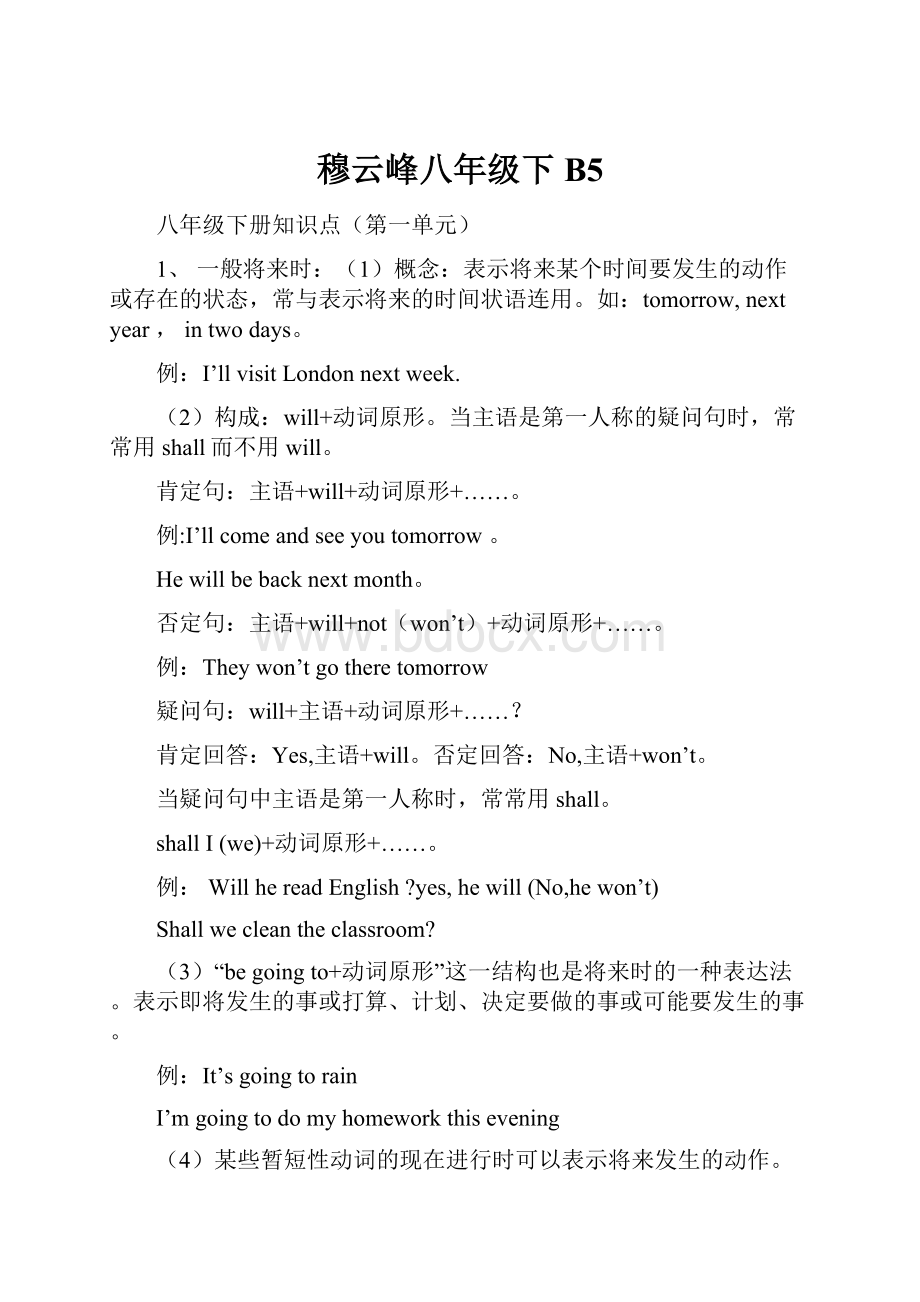穆云峰八年级下B5.docx
《穆云峰八年级下B5.docx》由会员分享,可在线阅读,更多相关《穆云峰八年级下B5.docx(32页珍藏版)》请在冰豆网上搜索。

穆云峰八年级下B5
八年级下册知识点(第一单元)
1、一般将来时:
(1)概念:
表示将来某个时间要发生的动作或存在的状态,常与表示将来的时间状语连用。
如:
tomorrow,nextyear,intwodays。
例:
I’llvisitLondonnextweek.
(2)构成:
will+动词原形。
当主语是第一人称的疑问句时,常常用shall而不用will。
肯定句:
主语+will+动词原形+……。
例:
I’llcomeandseeyoutomorrow。
Hewillbebacknextmonth。
否定句:
主语+will+not(won’t)+动词原形+……。
例:
Theywon’tgotheretomorrow
疑问句:
will+主语+动词原形+……?
肯定回答:
Yes,主语+will。
否定回答:
No,主语+won’t。
当疑问句中主语是第一人称时,常常用shall。
shallI(we)+动词原形+……。
例:
WillhereadEnglish?
yes,hewill(No,hewon’t)
Shallwecleantheclassroom?
(3)“begoingto+动词原形”这一结构也是将来时的一种表达法。
表示即将发生的事或打算、计划、决定要做的事或可能要发生的事。
例:
It’sgoingtorain
I’mgoingtodomyhomeworkthisevening
(4)某些暂短性动词的现在进行时可以表示将来发生的动作。
象:
go,come,leave,start,arrivereturnspendfly等。
例:
Myarntiscomingtoseeme
SheisflyingtoBeijingtomorrow.
(5)与一般将来时连用的时间状语。
thisafernoon(今天下午)、
thisevening(今天晚上)、tomorrow(明天)、tomorrow(明天上午)、
tomorrowafternoon(明天下午)、nextweek(下周)、nextyear(明年)。
in+一段时间,……后。
intwohours(两小时后)、intendays(十天后)、soon(不久)。
2、在“Therebe(is,are)+名词+介词短语”句型中,如果要表示“将来……”、“将有”、“将举行”、“将进行”,用“Therwillbe……”或“Thereisgoingtobe……”,绝对不能用“Therewillhave……”或“Thereisgoingtohave……”。
例:
Thereisgoingtobeaspeechcontesttomorrow.TherwillbeafootballgamenextMonday.
3、people.
(1)“人”,可数名词,单复数相同。
例:
twopeople,tenpeople.
(2)thepeople,“人民”。
例:
Westudyforthepeople.
4、use用、使用。
useful形容词“有用的”,useless形容词“无用的”。
例:
MayIuseyourbike?
Thisisausefulbook.
5、in、after、later的用法区别。
(1)in+一段时间。
“在……之后”,用于将来时。
例:
Theywillbebackintwoyears.
(2)after+一段时间。
也表示“在……之后”,用于一般过去时。
例:
Hewentbacktohishometownaftertenyears.
(3)“一段时间+later”,表示“……之后”,也用于一般过去时。
例:
Hewenttobedtwohourslater.
6、fall,落下,跌落。
(1)falloff,从……掉下来。
例:
Hefelloffhisbikeyesterday.==Hefelldownfromhisbikeyesterday.falloff==falldownfrom.
(2)fallbehind,落后。
例:
Workhardatyourlessons,oryouwillfallbehindothers.
(3)fallasleep入睡。
7、fallinlovewith,爱上、喜欢上。
例:
LastyearTomfellinlovewithagirl.
8、goskating去滑冰、gofishing去钓鱼、goboating去划船、gobiking去远足、goshopping去购物、goswimming去游泳。
9、puton穿上,指穿的动作。
可用于穿衣、穿鞋、戴帽等。
例:
Heputonhiscoatandwentout.wear“穿着”,指穿的状态。
宾语可以是衣服、鞋帽、眼镜等。
例:
Sheoftenwearsaredshirt.dress穿衣,宾语往往是人,dresssb给某人穿衣服。
例:
Theboycandresshimself.
10、What’stheweatherliketoday?
===How’stheweathertoday?
今天天气怎么样?
当询问将来的天气状况时可以用:
Whatwilltheweatherbelike?
==Howwilltheweatherbe?
例:
Whatwilltheweatherbeliketomorrow?
11、Cometrue指“(希望、理想、梦想、愿望等)实现”。
例:
Hisdreamcametrueatlast.
12、hundred百。
(1)表示确定的数字时用“基数词+hundred+名词复数”。
例:
twohundredbooks.
(2)表示不确定的数字时,用“hundredsof+名词复数”。
汉语意思为“数百的……”、“几百个……”。
例:
Therearehundredsofstudentsinourschool.我们学校有数百名学生。
13、bored形容词,“厌烦的”,一般只能放在be动词或get后边,主语只能是人。
例:
Hegotbored.Shewasbored.boring形容词,“令人厌烦的”,既可以修饰名词,也可以放be动词后作表语,但主语必须是事物。
例:
WatchingTVisboring.Thisisaboringgame.
14、lookfor、find与findout。
(1)lookfor“寻找”,强调寻找的过程。
例:
Heislookingforhislostpen.
(2)find“发现”,“找到”。
多指偶然发现、碰到。
例:
Shefoundapenontheground.
(3)findout“发现”、“弄清”、“找出”。
指通过调查研究而发现事情的真相。
例:
Thepolicefoundoutwhostolethebike.
15、noone==nobody.没有人。
做主语时谓语用单数,后边不能接of短语。
例:
Nooneishere.
16、letsbdosth.让某人做某事。
makesbdosth使某人干某事。
例:
Ourteachermakesuswritealotofwordseveryday.
17、wakeup醒来。
Wakesbup……叫醒。
例:
Iusuallywakeupatsixinthemorning.Pleasewakeyourfatherup.
18、agree同意、赞同。
(1)agreewith后接人或表示意思、看法的词。
(2)agreeto后接表示计划、建议、安排之类的词。
例:
Iagreewithyou.Theyagreetooursuggestion.建议。
19、flyrockets乘火箭飞行。
20、alone与lonely。
(1)alone可做副词,“单独地”、“独自地”。
例:
Theoldmanhasnochildren.Hehastolivelonely.也可做形容词,“单独的”、“独身的”。
表示客观的情况。
例:
MrWangisoftenaloneinhisoffice.
(2)lonely只做形容词,表示主观上感到“孤独的”。
例:
Theoldmanlivesalone,butheneverfellslonely.
21、livetobe+年龄。
“活到……岁”。
例:
Peoplewilllivetobe100yearsold.
22、need需要。
(1)当主语是人时,用needtodosth。
需要做……。
例:
Youneedtowearwarmcloths.
(2)当主语是物时,用needdoingsth。
(东西)需要……。
例:
Theclassroomneedscleaning.
23、so与such的区别。
“如此的”、“这样的”。
(1)so常用来修饰形容词或副词。
例:
sobig,sointeresting.such常用来修饰名词。
例:
suchabook,suchateacher
(2)so修饰形容词时后边可以有一个名词。
例:
sobeautifulacity而such修饰名词时,名词前也可以有一个形容词。
例:
suchacleverboy.注意:
so、such的语序。
so+形容词+a、an+名词。
sucha、an+形容词+名词。
24、inthefutuer与infutuer的区别。
inthefutuer“将来”、“未来”,指的是将来的某一时刻,不一定从现在开始。
例:
Iwanttobeateacherinthefutuer.infutuer,“今后”,指从现在开始的以后,相当于fromnowon。
例:
Imuststudyhardinfuture.
25、trytodosth设法或努力做某事。
trydoingsth试着做某事。
例:
I’lltrytoimprovemyEnglish.Hetriedwritingwithaballpen.圆珠笔。
26、theworldcup世界杯。
(1)help……with……,在……方面帮助……。
例:
CanyouhelpmewithmyEnglish?
(2)helpsb(to)dosth.帮助某人做某事。
例:
Weoftenhelptheoldwoman(to)carrywater.
(3)withthehelpof……,在……的帮助下,相当于withone’shelp。
例:
Withthehelpofmyteacher,Ifinishedmyhomework.(withmyteacher’shelp)
(4)helptodosth.帮助做某事。
八年级下册知识点(第二单元)
1、argue争论、争吵。
(1)arguewithsb与某人争吵。
例:
Don’targuewithyourmother.
(2)arguewithsbaboutsth.为某事与某人争吵。
例:
Sheoftenargueswithherfatheraboutherclothes.
2、either
(1)(两者之中的)任何一个。
例:
Therearemanytreesoneithersideofthestreet.Idon’twanteitherofthem.
(2)放在否定句的句末,“也”。
例:
Hecan’tswimandIcan’t,either.
(3)either……or……,或者……或者……。
一般情况下,either与or后边的词性要相同。
例:
YoucaneitherplaytheviolinorwatchTV.当either……or……在句中做主语时,谓语动词随or后边的主语变。
例:
Eitheryouorheisright.
3、pay……for……,付……钱买……。
例:
Iwillpaytendollarsforthebook.
4、maybe与maybe。
maybe副词。
“大概”、“也许”,相当于perhaps。
在句中作状语,常放句首。
例:
Maybeheisathome。
maybe在句中作谓语,“可能是在”|“也许是在”。
例:
Mymothermaybeathome.
5、beinstyle时髦的。
beoutofstyle不时髦的,过时的。
例:
Thispairofshoesisoutofstyle.Heskirtisinstyle.
6、wrong有毛病的。
What’swrongwithsb(sth).===What’sthematterwithsb(sth).某人(某物)怎么了?
例:
What’swrongwithyourmother?
Shefeelsterrible.What’swrongwithhisbike?
It’sbroken.
7、borrow……from……,从……借……。
例:
Ioftenborrowbikesfromhim.lend……to……,把……借给……。
Don’tlendyourmoneytoothers.
8、callsbup给某人打电话。
相当于ringsbup或者givesbacall、givesbaring。
例:
MrGreencalledmeupyesterday.===MrGreengavemeacall(ring)yesterday.
9、情态动词should的用法。
情态动词should“应该”,后边接动词原型,变疑问句时,把情态动词should提前,变否定句时,在后加not。
(can、must、may、could)例:
Youshouldstudyhard.Theyshouldn’targue.ShouldhewatchTVnow?
10、could“可以”。
后边接动词原型,变否定句时,在could后加not。
例:
Shecouldgonow.现在她可以走了。
11、ask……for……向……要……。
例:
Youmayaskyourparentsforsomemoney.
12、getsbtodosth.让某人做某事。
ask(tell、invite)sbtodosth.例:
Ourmathteacheroftengetsustoanswerquestions.
13、thesame……as……,与……一样,与……相同。
bedifferentfrom……与……不同。
例:
Myshoesarethesameasyours.
14、except与besides。
(1)excep除……之外。
(不包括excep后边的内容)。
例:
WewenttotheparkexcepTom.
(2)besides除……之外还有。
例:
WewenttotheparkbesidesTom.
15、leave与forget,“遗忘”。
leave主要指遗忘东西,后边接名词或代词后,常接地点状语,“leave+名词(代词)+介词短语”。
把……遗忘在某地。
例:
MyEnglishteacherlefthisbookonthetable。
forget主要指遗忘事情。
例:
Iforgotthetime.
16、allkindsof+名词,各种各样的……。
例:
Thereareallkindsoffoodintheshop.
17、complain抱怨。
complaintosbaboutsth,向某人抱怨某事。
例:
Shealwayscomplainstomeaboutherjob.
18、send发送,寄。
Sendsbsth==sendsthtosb.给某人寄(送)某物。
例:
Mypenpaloftensendsmesomepostcards.
19、findit+形容词+todosth……,发现做某事是……。
例:
IfounditeasytolearnEnglish.
20、ontheonehand……,ontheotherhand……。
一方面……另一方面……。
例:
Ontheonehand,shestudiesveryhard,ontheotherhand,sheisalwayslateforclass.
21、Geton相处,进展。
(1)geton(along)wellwithsb.与某人处得融洽。
(2)geton(along)wellwithsth.某事进展顺利。
例:
Tomgetson(along)wellwithhisclassmates.Shegetson(along)wellwithherstudies.她的学习进展很好。
22、not……until……,直到……才……。
not常与助动词、情态动词缩写,until后边可接单词,也可接句子。
例:
Iwon’tbelieveyouuntilyoucomeback.
Hedidn’tgohomeuntilteno’clockyesterdayevening.如果not……until……句型中没有not,则until译为“直到……为止”。
例:
Iwillwaitforyouuntilyoufinishyourhomework.
23、fromactivitytoactivity,一个接一个的活动。
24、toomuch太多……。
修饰不可数名词。
例:
Don’teattoomuchjunkfood.muchtoo太……。
修饰形容词或副词。
例:
Hewasmuchtoohappy.
25、something、anything、nothing,这些词被形容词修饰时,形容词应放后边。
例:
Ihavesomethingnewtotellyou.Doyouhearanythinginteresting?
26、主语+findit+形容词+todosth。
发现做……怎么样。
例:
IfinditeasytolearnEnglish.Doyoufinditboringtowatchgames?
27、compare……with……,与……相比较……。
例:
Don’tcompareyourselfwithothers.compare……to……,把……比做……。
例:
Manyparentscomparetheirchildentothesun.
28、must与haveto的区别。
(1)must情态动词,“必须”,后接动词原型。
表示人的主观看法。
例:
Imustfinishmyhomeworkeveryday.must的否定形式是mustnot或mustn’t,表示“不应该”、“不许”。
例:
Youmustn’twastetime.must引导的一般疑问句,肯定回答用Yes,主语+must。
否定回答用:
No,主语+needn’t或No,主语+don’thaveto.(不必)。
例:
Mustwecleartheroomfirst?
Yes,younust.No,youneedn’t.(don’thaveto).mustbe表示对事物的判断或推测。
“一定是(在)”、“准是(在)”。
把含有mustbe的句子变否定句时,应把must改成can’t。
例:
Hemustbeathome.→He
can’tbeathome.
(2)haveto+动词原形,“必须”、“不得不”。
表示因客观需要必须做某事。
例:
Ihavetolookaftermysister.“haveto+动词原形”的否定形式是“don’thaveto+动词原形”,表示“不必”。
例:
Youdon’thavetoworryaboutme.
29、onthephone用电话,通过电话。
30、haveabakesale卖烧烤。
31、seem的用法。
“似乎”、“好象”。
(1)seem后可接todosth。
Seemtodosth似乎(好象)做某事。
例:
Iseemtoknowthatgirl.
(2)seem+形容词。
例:
Thisstoryseemsinteresting.
(3)Itseems(seemed)that+句子。
看起来似乎……。
例:
ItseemsthatIknowher.
32、It’s+形容词+forsb+todosth。
做某事对某人是……。
例:
It’seasyformetoplaysoccer.这个句型中当形容词是“clever、friendly、nice、kind”时,常用ofsb,形容词修饰的是sb。
例:
It’scleverofyoutoanswerthisquestion.
33、Stopdoingsth停止做某事。
例:
PleasestopwatchingTV.stoptodosth停下来,去做……。
例:
Pleasestoptohavearest.
34、theticketto……,……的票。
例:
theticketstothemovie.
八年级下册知识点(第三单元)
1、feelunderpressure感到有压力。
例:
Doyoufeelunderpressureinourschool?
2、疑问词(where、which、what、how)+todosth。
这种结构称之为“疑问词+动词不定式”。
这种结构在句中可做主语、宾语和表语。
例:
Idon’tknowwheretogo.ShewantstoknowhowtostudyEnglish.Ican’tdesidewhichonetobuy.
3、getout出去、离开。
getoutof从……出去(出来)。
例:
Shegotoutofthecarjustnow.